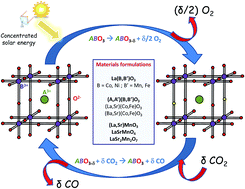当前位置:
X-MOL 学术
›
Sustain. Energy Fuels
›
论文详情
Our official English website, www.x-mol.net, welcomes your feedback! (Note: you will need to create a separate account there.)
Experimental screening of perovskite oxides as efficient redox materials for solar thermochemical CO2 conversion†
Sustainable Energy & Fuels ( IF 5.6 ) Pub Date : 2018-02-05 00:00:00 , DOI: 10.1039/c7se00516d Mahesh M. Nair 1, 2, 3, 4 , Stéphane Abanades 1, 2, 3, 4
Sustainable Energy & Fuels ( IF 5.6 ) Pub Date : 2018-02-05 00:00:00 , DOI: 10.1039/c7se00516d Mahesh M. Nair 1, 2, 3, 4 , Stéphane Abanades 1, 2, 3, 4
Affiliation

|
Developing efficient redox materials for the thermochemical synthesis of renewable fuels from CO2 and H2O via two-step redox cycling by utilizing concentrated solar energy is a major challenge that needs to be overcome for the realization of the solar fuel technology. Metal oxide redox materials are receiving recent interest on this regard, among which perovskite structured mixed oxides with lattice oxygen transfer are particularly important. In this contribution, we examined a series of perovskites and related Ruddlesden–Popper (RP) structures for their effectiveness in solar thermochemical conversion of CO2. All the materials used in this study were synthesized from the corresponding oxides by following the conventional solid state method. Substitutions were made on the cationic A and B sites in the structure in order to modify their redox properties and to enhance their stability under the reaction conditions. In conjugation, with the compositional tailoring of the perovskite materials, the temperatures of reduction and re-oxidation were varied. Issues regarding carbonate formation were identified, for some compositions so as to affect their CO2-splitting efficiency. Also in some cases, despite the higher extent of reduction observed at low temperatures, given the presence of Co4+, Fe4+ valence states, the extent of re-oxidation and stability were comparatively lower (case of (La,Sr)(Co,Fe)O3, (Ba,Sr)(Co,Fe)O3). The best performance among the investigated series was observed for La(B,B′)O3 perovskites with Mn and Ni or Mn and Co together in the B site, as well as strontium doped lanthanum manganites with perovskite (La0.5Sr0.5MnO3) and parent RP structures. Ruddlesden–Popper materials with only Mn occupying the B-site (LaSrMnO4, LaSr2Mn2O7), exhibited noteworthy thermochemical stability for two-step redox cycling and the amount of produced CO was consistently higher without any microstructural or morphological optimization at this stage.
中文翻译:

实验筛选钙钛矿氧化物作为太阳能热化学转化CO 2的有效氧化还原材料†
通过利用浓缩太阳能通过两步氧化还原循环开发用于从CO 2和H 2 O热化学合成可再生燃料的高效氧化还原材料是实现太阳能燃料技术需要克服的主要挑战。在这方面,金属氧化物氧化还原材料最近受到关注,其中,具有晶格氧转移的钙钛矿结构混合氧化物特别重要。在这项贡献中,我们研究了一系列钙钛矿和相关的Ruddlesden-Popper(RP)结构在太阳能热化学转化CO 2中的有效性。。本研究中使用的所有材料均按照常规固态方法由相应的氧化物合成。在结构中的阳离子A和B位上进行取代,以修饰其氧化还原特性并增强其在反应条件下的稳定性。在结合时,通过钙钛矿材料的组成调整,还原和再氧化的温度是变化的。对于一些组合物,已经确定了与碳酸盐形成有关的问题,从而影响了它们的CO 2分解效率。同样在某些情况下,尽管在低温下观察到较高程度的还原,但由于存在Co 4+,Fe 4+价态,再氧化程度和稳定性相对较低((La,Sr)(Co,Fe)O 3,(Ba,Sr)(Co,Fe)O 3的情况)。在所研究的系列中,观察到最佳性能的是在B位置具有Mn和Ni或Mn和Co的La(B,B')O 3钙钛矿,以及具有钙钛矿的锶掺杂镧锰矿(La 0.5 Sr 0.5 MnO 3)和父级RP结构。Ruddlesden–Popper材料中只有Mn占据B位(LaSrMnO 4,LaSr 2 Mn 2 O 7),在两步氧化还原循环中表现出显着的热化学稳定性,并且在此阶段没有任何微观结构或形态优化的情况下,产生的CO量始终较高。
更新日期:2018-02-05
中文翻译:

实验筛选钙钛矿氧化物作为太阳能热化学转化CO 2的有效氧化还原材料†
通过利用浓缩太阳能通过两步氧化还原循环开发用于从CO 2和H 2 O热化学合成可再生燃料的高效氧化还原材料是实现太阳能燃料技术需要克服的主要挑战。在这方面,金属氧化物氧化还原材料最近受到关注,其中,具有晶格氧转移的钙钛矿结构混合氧化物特别重要。在这项贡献中,我们研究了一系列钙钛矿和相关的Ruddlesden-Popper(RP)结构在太阳能热化学转化CO 2中的有效性。。本研究中使用的所有材料均按照常规固态方法由相应的氧化物合成。在结构中的阳离子A和B位上进行取代,以修饰其氧化还原特性并增强其在反应条件下的稳定性。在结合时,通过钙钛矿材料的组成调整,还原和再氧化的温度是变化的。对于一些组合物,已经确定了与碳酸盐形成有关的问题,从而影响了它们的CO 2分解效率。同样在某些情况下,尽管在低温下观察到较高程度的还原,但由于存在Co 4+,Fe 4+价态,再氧化程度和稳定性相对较低((La,Sr)(Co,Fe)O 3,(Ba,Sr)(Co,Fe)O 3的情况)。在所研究的系列中,观察到最佳性能的是在B位置具有Mn和Ni或Mn和Co的La(B,B')O 3钙钛矿,以及具有钙钛矿的锶掺杂镧锰矿(La 0.5 Sr 0.5 MnO 3)和父级RP结构。Ruddlesden–Popper材料中只有Mn占据B位(LaSrMnO 4,LaSr 2 Mn 2 O 7),在两步氧化还原循环中表现出显着的热化学稳定性,并且在此阶段没有任何微观结构或形态优化的情况下,产生的CO量始终较高。



























 京公网安备 11010802027423号
京公网安备 11010802027423号